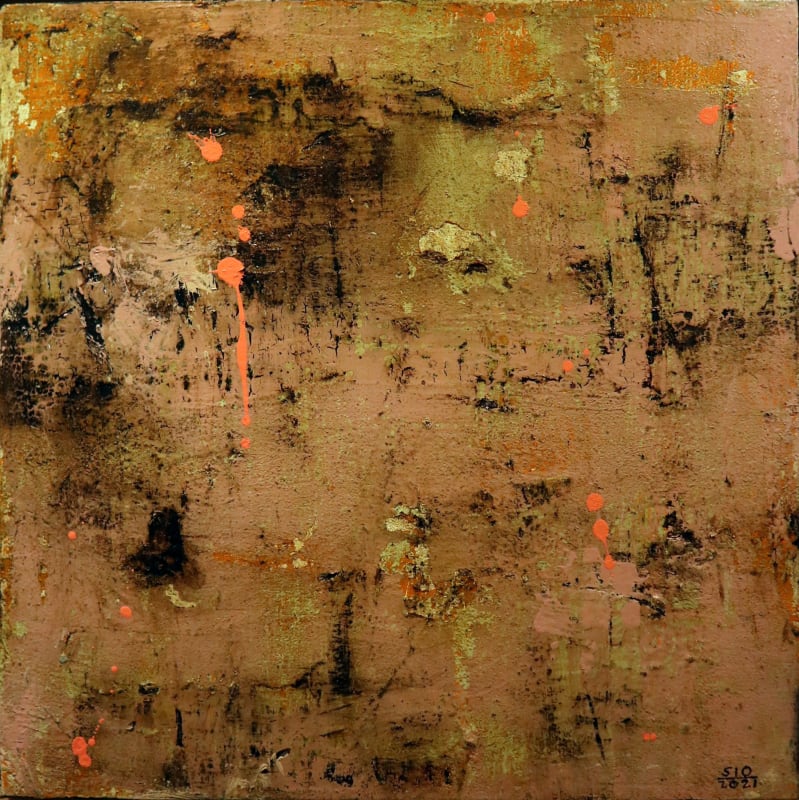At first look, abstract art seems to be actually quite concrete. It strips art of all garbs and bares the material itself in its naked glory.
It brings to the foreground the texture, the pigments, the colors, and all other visual elements in order to let them speak for themselves. Form no longer hides beneath familiar imagery and narrative. What can only be intelligible becomes incarnate, tactile and tangible.
And yet, as the theologians would say about the mystery of incarnation: "the formless takes form and becomes formless again". From the intelligible and the sensory, we are drawn back into the unknown. There is something left undisclosed in the nakedness of the material. Something indeterminate can only be hinted by the visual.
What we see on the surface of the canvas can only be traces or ciphers to some distant or vague memory--that of the artist but also that of the viewer. Art at this level of the unconscious seems to speak a common language, a collective yet vague memory.
These thoughts come to mind as we look at the recent series of the artist Dennis "Sio" Montera. Sio has long abandoned what he calls "the concept of art as mimesis", that rather prolonged pursuit of likeness in the painted image and the object it seeks to represent, in favor of art that is devoid of such representation. "Abstraction challenged me in ways that representation could not," he says. One wonders what this challenge might be. Why so many good figurative painters turn to abstraction late in their career? What is it in abstract art, now more than a century since Kandinsky pioneered it, continues to draw the most contemplative of the painters? How did abstract art persist in today's glorification of contemporariness?
As an academic with a doctorate on his sleeve, Sio is not a stranger to contemporary art discourse. Perhaps, it is because he had too much of it that he retreated into the inner world of total abstraction. No longer bound by explicit content, he only has to deal with pure form. Or rather how form does not merely become the "shape of content", as Ben Shahn would say, but content itself. "My approach is firmly grounded on formalism as a methodology of art," Sio says. "Form over content continues to be guiding principle every time I stare into the void of a blank canvas."
Surely, Sio has grappled with the problems of pure composition in most of his work, alternating between the sheer delight with harmonious form and form that follows feeling. In the latter, the artist aims to let the unconscious guide him by way of gestural movement, chance and accidents in the act of painting that culminate into form, where everything somehow falls in place.
The distressed canvas, for example, may evoke the patina on the walls and doors of the Buddhist temples that Sio frequented while studying in Taiwan. The peeled paint revealing underpainting, not only suggests what had been hidden or forgotten, a chance discovery similar to how the French decollage artists mimicked the stripped subway posters revealing parts of another poster underneath. Art becomes a way of unconcealment.
Swirls, arabesques, and quick jabs of paints more dripped or splattered rather than applied with a brush recall Sio's encounters with ancient Chinese calligraphy and ink paintings. Sometimes, the canvas takes on incisions, scratches and all forms of torture. Thus, these gestures express calculation or spontaneity, various mental and emotional states that the artist went through in the course of creation. They are traces of the inexplicable, visual articulations of what is actually ambiguous and unfathomable.
It might help to note that this recent series is dedicated by Sio to his father who just passed away, yet another private tragedy that is easily unnoticed in a pandemic. But encounters with death always induce meditations on the eternal. Thus, what seems to be all too concrete and tactile actually belies the spiritual. Abstraction reveals a more powerful force that the artist can only yield to. It inspires but also commands him in his work.
Technique becomes a spiritual process, a form of ritual or meditation. Indeed, as Sio himself describes his work: "The act of painting becomes the painting itself and significant form is finally achieved when all the elements are in harmony with one another on the picture plane. Personally, the work's composition in the finished product is an end result of the artistic process. The work's surface also reveals the 'histories' of my process as section of various layers are left visible to the viewer, offering a deeper look into the complexity of my art production. The lines, markings, strokes, drips, stains, scratches, peels, and paint splatters are also imprints of the physical energy involved during the process."
This procedure, according to Sio, involves a lot of layering, repeated gestural strokes, "performed again several times until the 'aha-moment’ arrives, an indescribable feeling when your heart would skip a beat and your mind would nod in agreement that you have reached the climax of the work's form (or the sublime). Sometimes it would take days, weeks, and even months before the form that satisfies me would eventually reveal itself. As a serious abstractionist for more than 20 years, I wait for this moment every time and never compromise."
It is this ritualistic and performative aspect of abstract expressionism, how it locates meaning in both thought and technique, in process as it is in the finished product, that makes it the true precursor of conceptual art, which today has reduced itself to mere wit or bland theory-as-art.
Such are the paradoxes of abstract art: It is material and spiritual, form and feeling, object and idea, spectacle and memory.
- Radel Paredes

